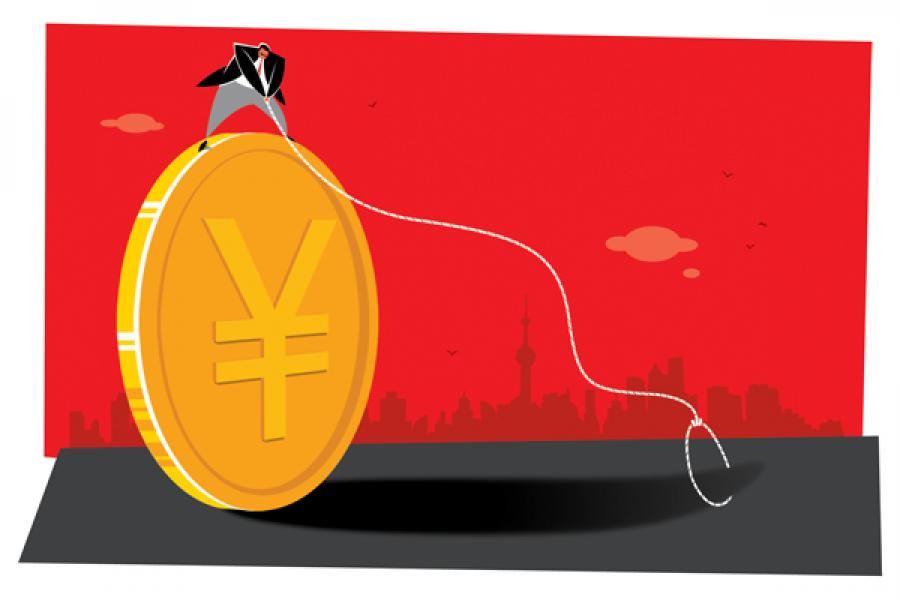
Reining In China's Shadow Banking System
The central government announced plans for new private banks to increase the system's capacity outside the dominant state-owned lenders
China faces two separate, but inter-related problems—rapidly increasing levels of debt and the structure of its financial system, specifically the growth of its shadow banking system. Dealing with these two issues is complex.
The Chinese shadow banking system poses increasing risk. While the exact size is disputed, it is estimated to be around 70-100 percent of GDP ($6-9 trillion) and growing rapidly.
With the Chinese banks’ share of new lending having fallen from 90 percent a decade ago to around 50 percent, the economy has become increasingly reliant on shadow banks as an important source of finance, especially for local governments, property companies and small and medium-sized enterprises (SMEs).
While the majority of Wealth Management Products (WMPs) are invested in inter-bank deposits, money markets and bond markets, the credit quality of many borrowers from shadow banks is uneven. Collateral securing loan is variable. A high proportion of trust loans and some WMP investments are secured by real estate. This exposes investors to losses if property values fall sharply. The Golden Elephant No 38 WMP, which offered investors 7.2 percent per annum, was found to be secured by a deserted housing estate in a rice field in Jiangxi province.
Increasingly, other forms of riskier collateral such as industrial machinery and commodities have become more common. In a few more extreme cases, the collateral has been more exotic (tea, spirits, graveyards, etc). In some cases, lenders seeking to foreclose loans have discovered that the underlying collateral has been pledged more than once or does not actually exist.
The products entail significant asset-liability mismatches with short-dated investor funds being used to finance long-term assets which are sometimes non-income producing, for example, undeveloped land. The constant repayment or refinance requirement exposes the vehicles and the financial system to the risk of a liquidity crisis. For example, in 2014, around $660 billion of trust products alone mature.
The trust companies and financial guarantors frequently lack adequate capital. Trust companies have average leverage of over 20 times which is high given the nature of investments.
Many products do not detail the exact use of investor funds. The documentation is vague. Due diligence by the sponsor or investment managers, enforceability of security interests and investor rights are unclear. As the system operates with only limited regulations, controls and oversight are weak.
Inter-connections between the shadow banking system and the traditional banking system create additional risk and moral hazards.
Banks frequently use shadow banking to shift loan assets off their balance sheets and “window dress” financial statements for regulators and investors. Banks also use trust companies and WMPs to arrange high interest loans to companies, such as property developers, that they are unable to lend to due to regulatory risks.
Banks work closely with trust companies and security brokers to create investment products for depositors seeking higher returns, effectively acting as a conduit between savers and borrowers. Bank issuance of WMPs has increased 25-30 times from around $100 billion to $2.5-3 trillion. Banks increasingly rely on these products to maintain market share and earnings via fees and commissions received from distributing shadow banking products.
The linkages can be complex. Banks sell acceptance bills or risky loans to a trust which is then repackaged as a WMP to be sold to bank clients. There are transactions between different shadow banking entities. A financial guarantee can be used by a firm or individual to borrow from a bank with the proceeds invested in a trust or WMP. Banks, trusts and WMPs sometimes pool deposits as well as assets or securities from different schemes. New products are created to raise funds to meet repayments of maturing products.
In principle, the risk of these structures and investment rest with the investors. WMPs state that returns are expected rather than guaranteed or promised returns. WMP investors are typically required to confirm that they will bear the financial shortfall if assets funded by the pool default. In part, these provisions are included to ensure that WMP sponsors are able to keep the liabilities raised from investors and the assets purchased off balance sheet. But the ultimate responsibility for defaults is more complicated.
Investors in trusts may believe that they are protected from loss because the trust companies risk losing their operating licence if their products suffer losses. In recent years, trust companies have sometimes concealed losses by using their own capital, arranging for state-owned entities to take over impaired loans or using proceeds from new trusts to repay maturing investments.
Investors may also assume that banks will guarantee repayment and returns on shadow banking investment. This impression is reinforced by the transfer of bank assets to trust companies and WMPs and the distribution of shadow bank products by banks.
These problems are compounded by the lack of sophistication of some buyers and willful ignorance of others. Banks also bear reputational risk.
Regulators would be concerned about systemic risks.
Failure of a riskier trust or WMP may lead to inability to issue fresh products or withdrawal of funds, requiring sponsoring banks to support these vehicles as it happened in 2007-08 in developed markets. The resulting losses and cash outflows could trigger wider problems within the financial system which would affect solvent businesses and growth.
Policymakers would also be concerned about customer anger. In recent years, there have been a number of scandals where investors who had invested in products believing that they were guaranteed by the selling banks laid siege to the sponsoring bank. The high political risk may result in governments forcing banks to support the structures to avoid any threat to social stability.
Putting Worms Back In Cans…
In recent years, policymakers have taken steps to slow the rapid growth in debt and the expansion of the shadow banking system.
They have used quantitative measures to reduce credit creation, increasing reserve requirements to reduce bank lending. Qualitative measures, primarily loan quotes and specific restrictions on certain types of loans, have been used to control borrowing growth.
In early 2014, the central government announced plans for measures designed to rein in shadow banks. Banks are to be subjected to more rigorous enforcement of existing rules and bans on moving certain loans and assets off balance sheets. Banks would be required to set up separately capitalised and provisioned units for wealth management businesses. Cooperation between banks and trust companies or security brokers would be restricted.
Trust companies would be prohibited from pooling deposits from more than one product or investing in non-tradable assets. Private equity firms would not be allowed to lend to clients.
The central government also announced plans for three to five new private banks to increase the capacity of the banking system outside the dominant state-owned lenders.
In mid-2013 and in early 2014, the authorities also intervened in money markets, draining liquidity and increasing interest rates to restrict excessive credit growth and to improve bank risk management practices. The actions resulted in a sharp rise in interest rates (in June 2013, they crossed over 13 percent) and increased volatility. They also revealed weaknesses in the structure of the financial system, particularly the instability of the shadow banking system.
The large Chinese state banks control the major proportion of customer deposits. Other banks tend to have smaller deposit bases. They are more reliant on wholesale funding, particularly from the inter-bank market. Liquidity in the inter-bank market depends on the larger banks who are net lenders in this segment and WMPs which invest in money market instruments, many of which are sponsored by smaller banks.
Reduced liquidity and higher rates can quickly set off a chain reaction. Tighter conditions in the interbank market place pressure on smaller banks. It also triggers redemption of WMPs which further reduces availability of funding in the interbank markets, setting off a cycle of increasing rates. Unlike large banks, smaller banks hold lower amounts of government bonds limiting their ability to raise funds using the securities as collateral in repos. Smaller banks may be forced into distressed selling of illiquid assets, causing prices to fall.
The deteriorating financial position of smaller banks would force up their cost of borrowing. Some banks can lose access to funding due to concerns about their solvency.
The actions of authorities can affect solvent and viable businesses in an undesirable way. In June 2013, the interest rate for AAA-rated corporate bonds rose rapidly by 2 percent per annum. Like the experience of money markets in developed countries during 2007-2008, scarcity of funds, payment issues combined with payment or solvency issues in small banks or the shadow banking system can quickly trigger broader economic problems.
Despite the increasing urgency of intervention, the actions have had limited success in slowing in the growth of borrowings.
A central problem is the reliance on debt-funded economic growth and the need to expand credit to maintain high levels of economic activity. In addition, the increase in the size and complexity of the shadow banking sector reflects structural problems. The need is for major and widely based economic, financial and structural reform, which is politically unpalatable.
As a consequence, attempts to slow credit growth, regulate the shadow banks and reduce speculation are inconclusive. After both episodes of intervention by the central banks, authorities stepped in and supplied significant amounts of liquidity to alleviate concerns about a slowdown in growth and financial problems.
Responding to the regulations covering shadow banking in January 2014, Anne Stevenson-Yang at J-Capital wrote: “The hilarious new Document 107 on shadow banking betrays how toothless the government is in the face of the mounting debt because the only solution presented is more debt.”
Satyajit Das is a former banker and author of Extreme Money and Traders Guns & Money
(This story appears in the 03 October, 2014 issue of Forbes India. To visit our Archives, click here.)

















